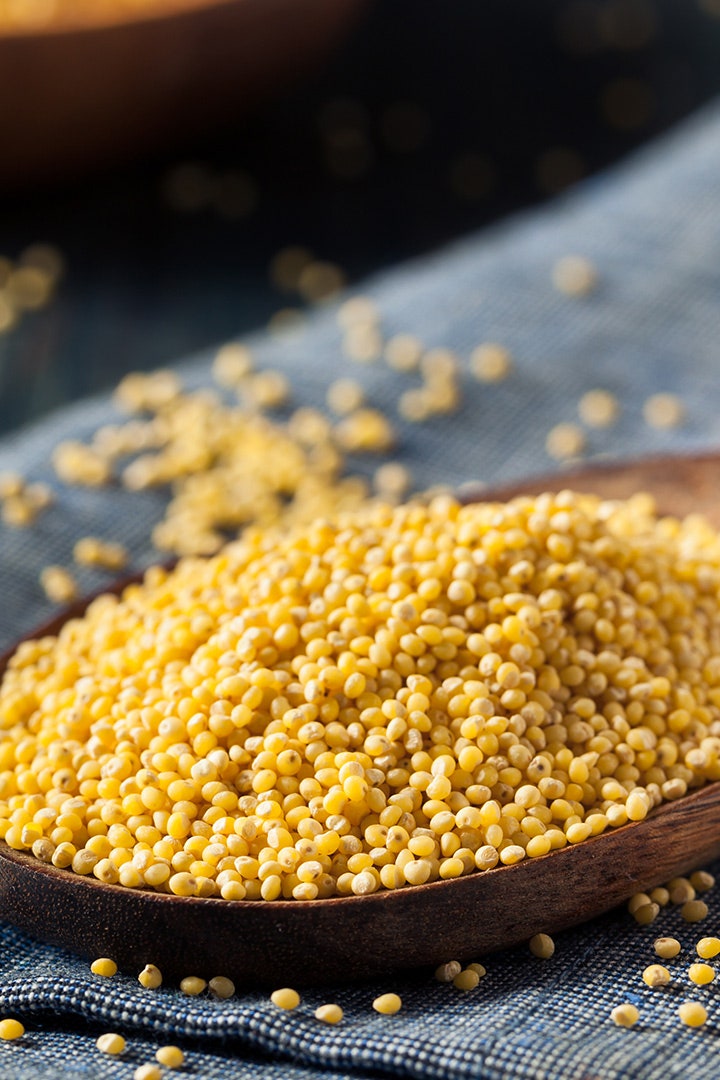
Move over quinoa, there’s a new staple in town. While millets are seeing a resurgence of sorts, the truth is that they’ve been around since time immemorial. In fact, in the 1940s and ’50s, they were the staple food in our country instead of wheat and rice. It’s only after the green revolution in the ’60s that they were completely replaced. But millets are hardy grains, because they’re like weeds that cannot completely be eliminated. “They’re real fighters because they don’t require any fertilisers, water or pesticides to grow; in fact they can withstand drought or even very hot and cold temperatures,” says Lovneet Batra, Delhi-based sports nutritionist, who has counselled the Indian boxing, gymnastics, cycling and archery teams during the Commonwealth and Asian Games.
________________________________________________________________________
Read Also : How the ‘Orange Areas’ Dispute in Central India Leaves Dalit, Adivasi Farmers Without Land…
She gives the example of Rajasthan with its extreme temperatures and water shortage. “Millets are still commonly eaten there.” She explains that the best part of millets is that not only are they packed with macro nutrients such as fibre and protein, but also trace minerals and vitamins. These would include iron, vitamin B6 (which helps control high prolactin levels) and magnesium (that is essential for bone health). “Millets also provide sustainable energy—they fill you up without feeling heavy and leave you feeling full for a long time.” Because these grains grow like weeds, most millets are naturally non-GMO and pesticide free. What’s more, there are different varieties that you can eat in summers and others for winter. Batra breaks it down according to seasons and methods of preparation.
Winter millets
Finger millet
Also known as ragi, this millet is high in calcium and has iron that is more bioavailable for the body. “This means that even though ragi may not be super high in iron, it is easily absorbed by our bodies as compared to other vegetarian sources.” In fact, it is so effective that it is commonly used to treat anaemia in low income group women and children.
________________________________________________________________________
Read Also : Is stevia a healthy alternative? Everything you should know,
________________________________________________________________________
How to eat it: Roast whole ragi on a hot griddle (it won’t puff). You can eat it with roasted black gram, peanuts, and , or eat it like a chaat with puffed rice. You can also make ragi porridge by warming its flour with coconut milk, stirring constantly to avoid lumps.
Pearl millet
Locally known as bajra, this is a winter favourite because it’s extremely warming and strengthening for the body, especially for muscles and bones. “It can be a bit drying, therefore it must be consumed along with ghee, whether you make a roti or khichadi.”
How to eat it: You can even mix a tbsp of this millet in 500ml of water along with jaggery and drink it before a workout, as it has high protein and provides sustainable energy. You can replace bajra with sorghum in the summer.
Summer millets
Sorghum or jowar
Called jowar in Hindi, this millet is extremely cooling and is packed with B-vitamins and minerals, therefore it is excellent for skin and hair.
How to eat it: Either as a pre-workout drink (see above) or as a roti. Jowar is difficult to roll into rotis by itself, so its flour can be mixed with a boiled potato to make it more malleable.
Barley
This is the only millet that contains gluten, however this is extremely beneficial to reduce bloating and UTI. “Barley (also known as jau) is also the most energising out of all millets.”
Move over quinoa, there’s a new staple in town. While millets are seeing a resurgence of sorts, the truth is that they’ve been around since time immemorial. In fact, in the 1940s and ’50s, they were the staple food in our country instead of wheat and rice. It’s only after the green revolution in the ’60s that they were completely replaced. But millets are hardy grains, because they’re like weeds that cannot completely be eliminated. “They’re real fighters because they don’t require any fertilisers, water or pesticides to grow; in fact they can withstand drought or even very hot and cold temperatures,” says Lovneet Batra, Delhi-based sports nutritionist, who has counselled the Indian boxing, gymnastics, cycling and archery teams during the Commonwealth and Asian Games.
She gives the example of Rajasthan with its extreme temperatures and water shortage. “Millets are still commonly eaten there.” She explains that the best part of millets is that not only are they packed with macro nutrients such as fibre and protein, but also trace minerals and vitamins. These would include iron, vitamin B6 (which helps control high prolactin levels) and magnesium (that is essential for bone health). “Millets also provide sustainable energy—they fill you up without feeling heavy and leave you feeling full for a long time.” Because these grains grow like weeds, most millets are naturally non-GMO and pesticide free. What’s more, there are different varieties that you can eat in summers and others for winter. Batra breaks it down according to seasons and methods of preparation.
________________________________________________________________________
Read Also : Development or Destruction – Where we are heading to!
________________________________________________________________________
Winter millets
Finger millet
Also known as ragi, this millet is high in calcium and has iron that is more bioavailable for the body. “This means that even though ragi may not be super high in iron, it is easily absorbed by our bodies as compared to other vegetarian sources.” In fact, it is so effective that it is commonly used to treat anaemia in low income group women and children.
How to eat it: Roast whole ragi on a hot griddle (it won’t puff). You can eat it with roasted black gram, peanuts, and jaggery, or eat it like a chaat with puffed rice. You can also make ragi porridge by warming its flour with coconut milk, stirring constantly to avoid lumps.
Pearl millet
Locally known as bajra, this is a winter favourite because it’s extremely warming and strengthening for the body, especially for muscles and bones. “It can be a bit drying, therefore it must be consumed along with ghee, whether you make a roti or khichadi.”
How to eat it: You can even mix a tbsp of this millet in 500ml of water along with jaggery and drink it before a workout, as it has high protein and provides sustainable energy. You can replace bajra with sorghum in the summer.
Summer millets
Sorghum or jowar
Called jowar in Hindi, this millet is extremely cooling and is packed with B-vitamins and minerals, therefore it is excellent for skin and hair.
How to eat it: Either as a pre-workout drink (see above) or as a roti. Jowar is difficult to roll into rotis by itself, so its flour can be mixed with a boiled potato to make it more malleable.
Barley
This is the only millet that contains gluten, however this is extremely beneficial to reduce bloating and UTI. “Barley (also known as jau) is also the most energising out of all millets.”
How to eat: You can make rotis very easily with this grain, or you can soak and sprout it. If you have recurring UTI, try this recipe—boil a tsp of barley in a glass half-filled with water. Cover and let it sit overnight. Strain and drink in the morning on an empty stomach.
Little millet
Also called kutki, this is usually consumed during Navratri. It’s the most cooling out of all millets and is great for digestive health, because it contains high amounts of soluble fibre.
How to eat: You can cook and eat it exactly like rice, combining it with veggies or lentils, or making a healthy pilaf with this grain.
How to eat: You can make rotis very easily with this grain, or you can soak and sprout it. If you have recurring UTI, try this recipe—boil a tsp of barley in a glass half-filled with water. Cover and let it sit overnight. Strain and drink in the morning on an empty stomach.
Little millet
Also called kutki, this is usually consumed during Navratri. It’s the most cooling out of all millets and is great for digestive health, because it contains high amounts of soluble fibre.
How to eat: You can cook and eat it exactly like rice, combining it with veggies or lentils, or making a healthy pilaf with this grain.
The best diet tips to follow in your 50s—what to eat and what to avoid







